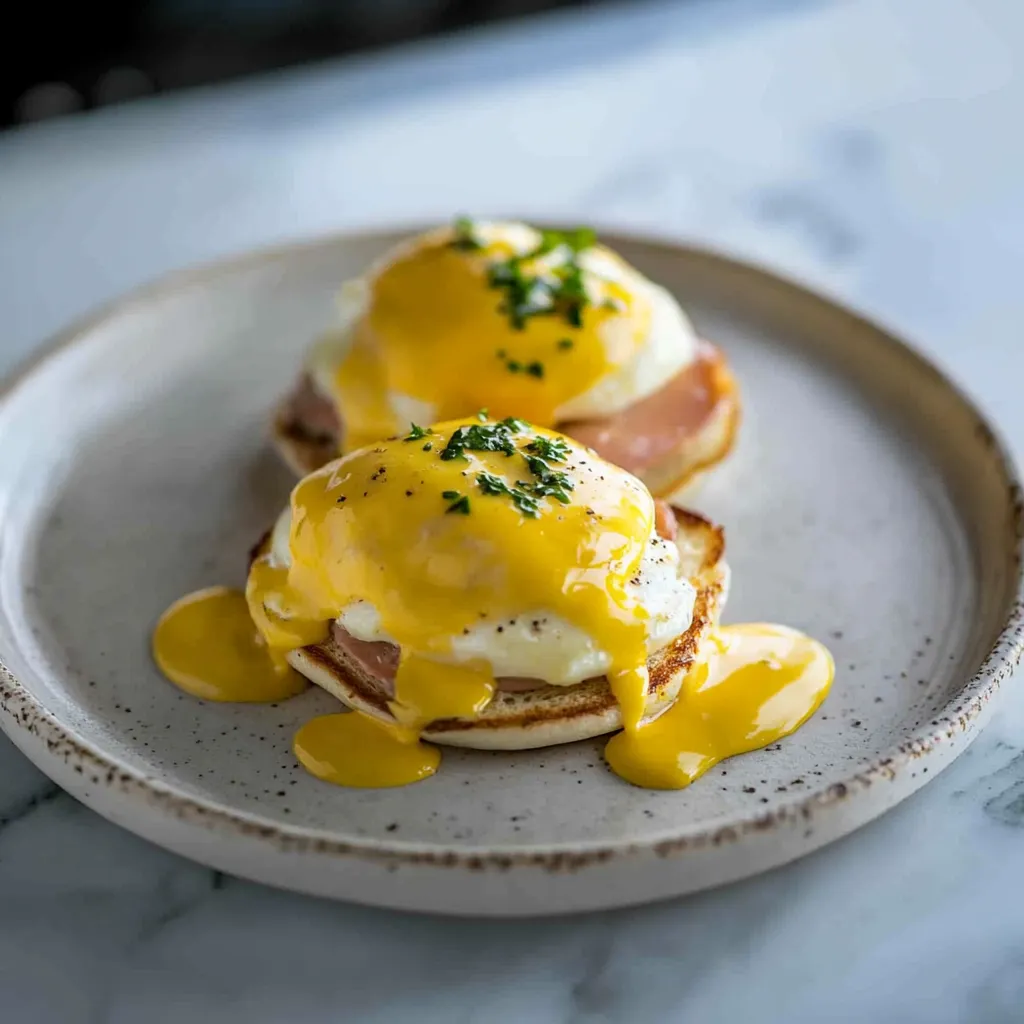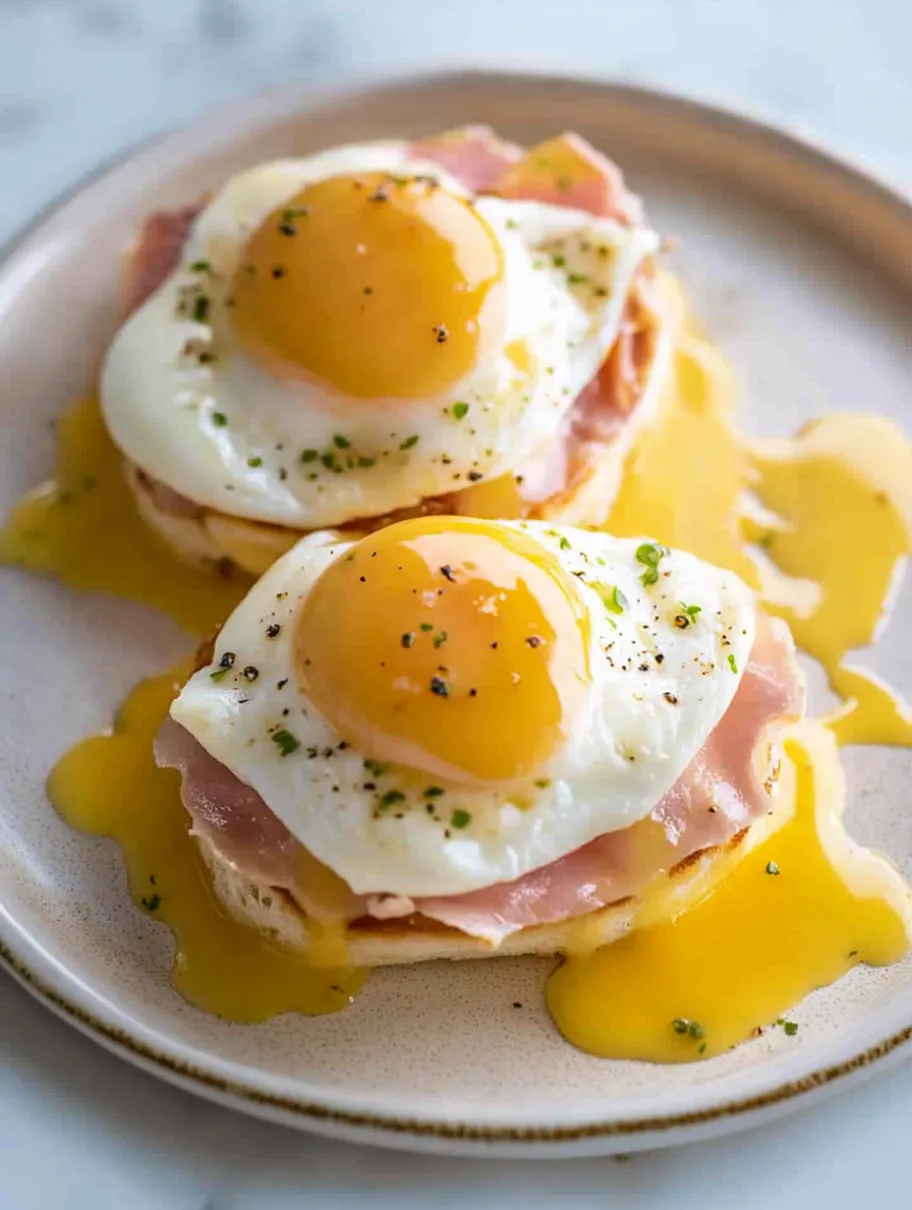 Save
Save
This classic Eggs Benedict has been my indulgent weekend breakfast ritual for years. The combination of a perfectly poached egg, savory Canadian bacon, and silky homemade hollandaise sauce creates the ultimate breakfast experience that feels like dining at a fancy brunch spot, right in your kitchen.
I first attempted Eggs Benedict during a lazy Sunday morning when I was craving something special but didn't want to change out of my pajamas. After perfecting this recipe, my family now requests it every holiday morning and special occasion.
Ingredients
- English muffins firm texture provides the perfect base for soaking up the luscious sauce
- Large eggs freshest eggs create the best poached results with perfect runny yolks
- Canadian bacon adds a smoky flavor and is leaner than traditional bacon
- Vinegar helps the egg whites stay together during poaching
- Butter use high quality unsalted butter for the richest hollandaise
- Egg yolks create the creamy base for hollandaise sauce
- Lemon juice adds brightness and balances the richness
- Heavy whipping cream helps achieve the perfect texture
- Salt and pepper season to your preference
Step-by-Step Instructions
- Prepare The Hollandaise Sauce
- Melt butter in a small saucepan until completely liquid but not browned. In a separate bowl, whisk the egg yolks until smooth and slightly lightened in color. Add the lemon juice, cream, salt and pepper to the yolks and mix thoroughly. The key to silky hollandaise is tempering the eggs by adding hot butter very gradually. Take a small spoonful of melted butter and whisk it into the egg mixture, repeating this process one spoonful at a time until all butter is incorporated. Return the mixture to the saucepan and cook on low heat for just 20 to 30 seconds, stirring constantly. The sauce will thicken as it cools. If it becomes too thick, add a splash of cream to reach your desired consistency.
- Poach The Eggs
- Fill a medium pot with about 3 inches of water and bring to a boil, then reduce to a gentle simmer where small bubbles come to the surface but aren't rolling vigorously. Add a splash of vinegar to the water to help the egg whites coagulate properly. Crack each egg individually into a small cup or measuring cup. Slowly lower the cup to the water surface and gently ease the egg into the simmering water. Cook for 3 to 5 minutes depending on how runny you prefer your yolk. Watch for the white to become opaque and set while maintaining a soft, jiggly center. Using a slotted spoon, carefully remove the eggs and place on a paper towel to absorb excess water. Do not worry about the white foam that may form during poaching you can simply skim it off with a spoon.
- Prepare Canadian Bacon
- While eggs are poaching, heat a large pan over medium high heat. Place Canadian bacon slices in the pan and cook for about one minute per side. The goal is to heat the meat through and achieve light browning for enhanced flavor. Remove from heat and set aside.
- Assemble Your Eggs Benedict
- Toast English muffins until golden brown with a slightly crispy exterior but still soft inside. Place toasted muffin halves on plates and top each with a slice of warmed Canadian bacon. Carefully place a poached egg on top of the bacon. Spoon generous amounts of hollandaise sauce over each egg, allowing it to cascade down the sides. Serve immediately while everything is still warm.

The first time I made this recipe for my husband, he declared it better than our favorite brunch spot. The secret is in the hollandaise sauce where I discovered that adding just a touch of cream creates a more forgiving sauce that stays silky even as it cools.
Hollandaise Troubleshooting
Hollandaise sauce has a reputation for being temperamental, but it doesn't have to be difficult. If your sauce breaks or separates, place a teaspoon of hot water in a clean bowl and slowly whisk in the broken sauce. This usually helps it come back together smoothly. For a thicker sauce, continue cooking a bit longer, but never let it boil. If your sauce is too thick, add a few drops of warm water or cream. The key is maintaining a very low heat and constant stirring during the final cooking stage.
Customization Options
While traditional Eggs Benedict calls for Canadian bacon, feel free to experiment with alternatives. Smoked salmon creates a luxurious variation known as Eggs Royale. For a vegetarian option, substitute with sautéed spinach and mushrooms, or sliced avocado. You can also add herbs to your hollandaise such as chopped chives, tarragon, or dill for an aromatic twist. Some families have a tradition of adding a thin slice of tomato beneath the Canadian bacon for extra freshness and acidity.
Make Ahead Tips
For entertaining, you can poach eggs up to 24 hours in advance. After poaching, transfer eggs to a bowl of ice water and refrigerate. When ready to serve, dip eggs in hot water for 20 to 30 seconds to rewarm before assembling. Hollandaise sauce is best made fresh, but can be held in a thermos for up to an hour. To reheat hollandaise gently, place the sauce in a bowl over simmering water and whisk occasionally until warm, adding a few drops of hot water if needed to maintain consistency.

Recipe FAQs
- → What's the secret to perfect hollandaise sauce?
The secret to perfect hollandaise is gradual temperature control. Add hot butter to egg yolks one spoonful at a time to avoid curdling. Cook over very low heat, stirring constantly, and remove after just 20-30 seconds. The sauce will thicken as it cools, and you can adjust consistency with a splash of cream if needed.
- → How do I poach eggs without them falling apart?
For intact poached eggs, use fresh eggs and simmer (don't boil) the water. Add a splash of vinegar to help the whites coagulate. Crack each egg into a small cup first, then gently ease it into the water. The foam that forms is normal and can be skimmed off. Cook for 3-5 minutes depending on your preferred yolk consistency.
- → Can I make hollandaise sauce ahead of time?
While best made fresh, hollandaise can be prepared up to an hour ahead and kept warm. Place it in a thermos or over a pan of warm (not hot) water. If it thickens too much, whisk in a few drops of warm water. For longer storage, refrigeration isn't recommended as the sauce may separate.
- → What can I substitute for Canadian bacon?
Traditional ham, bacon, smoked salmon, or avocado slices work well as substitutes for Canadian bacon. For vegetarian options, sautéed spinach, roasted tomatoes, or grilled portobello mushrooms provide savory alternatives that complement the poached egg and hollandaise nicely.
- → Why did my hollandaise sauce separate?
Hollandaise typically separates when it gets too hot or the butter is added too quickly. To fix a separated sauce, whisk a tablespoon of hot water into it vigorously. Alternatively, start with a fresh egg yolk in a clean bowl, and slowly whisk in the broken sauce bit by bit to re-emulsify.
- → How can I tell when a poached egg is perfectly cooked?
A perfectly poached egg has firm whites and a runny yolk. After 3 minutes, the whites should be set but the yolk still soft. Gently touch the egg with a spoon - it should feel soft but not wobbly. For firmer yolks, cook for 4-5 minutes. The egg will also firm up slightly after removal from water.
